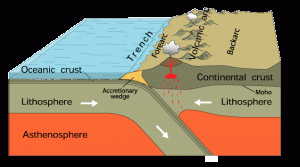Zbieżna granica płyt tektonicznych
Kiedy dwie płyty tektoniczne przesuwają się ku sobie, nazywa się to zbieżną granicą płyty (strefą subdukcji). Cięższa płytka oceaniczna ostatecznie zatonie pod lżejszą płytą kontynentalną. Łańcuch górski Andów jest przykładem, w którym ciężka płytka oceaniczna (płyta Nazca) wchodzi poniżej lżejszej płyty kontynentalnej (płyta południowoamerykańska).

Źródło: https://arstechnica.com/science/2015/04/magma-beneath-the-cascade-volcanoes-might-be-special-blend/


 This project (EDU-ARCTIC) has received funding from the European Union’s Horizon 2020 research and innovation programme under grant agreement No 710240. The content of the website is the sole responsibility of the Consortium and it does not represent the opinion of the European Commission, and the Commission is not responsible for any use that might be made of information contained.
This project (EDU-ARCTIC) has received funding from the European Union’s Horizon 2020 research and innovation programme under grant agreement No 710240. The content of the website is the sole responsibility of the Consortium and it does not represent the opinion of the European Commission, and the Commission is not responsible for any use that might be made of information contained.